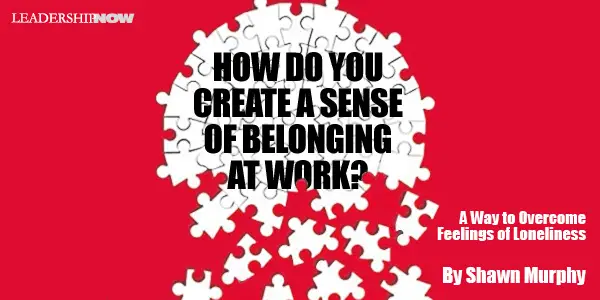 |
 |
05.13.20

How Do You Create A Sense of Belonging at Work?
IN a Cigna Health report from 2019, 61 percent of people in the study reported feeling lonely. Why? According to the findings, Americans felt that they don’t have enough social support, not enough meaningful interactions, struggle with physical and mental health issues, and can’t find a way to balance the demands in their personal and professional worlds. Well, with a global pandemic and shelter-in-place orders, employees are working from home and are forced to limit their physical interactions with colleagues, family, and friends. Feelings of loneliness and isolation are quite common today. However, companies and their leaders can do something to counteract the deleterious effects of loneliness. In the context of the workplace, loneliness undermines performance and productivity, at a minimum. Leaders can turn to a solution that costs little and has major dividends: a sense of belonging. Does this surprise you? It shouldn’t. Throughout human history, a sense of belonging has been ingrained into our DNA. The comfort of friendships and the safety derived from being part of a community have always been one of the most powerful forces shaping our human experience. What is belonging at work? It’s the experience of feeling valued, wanted, and welcomed. Feeling valued at work: When employees believe their contributions, effort, and personal sacrifices are expressly appreciated. Feeling wanted at work: When employees believe their boss and the organization care about them as a whole person and not simply as a means to an end. Feeling welcomed at work: When employees believe they have a place in their team When leaders can shape the experience of belonging, employees are positioned to drive better business results. What’s more, in this era of working from home, belonging helps combat feelings of loneliness. My research on belonging in high-performing companies like the Container Store, LinkedIn, and Barry-Wehmiller show that relating to employees as people – and not just resources to get work done – can lead to tightly-knit teams that deliver breakthrough performances and astonishing results. So how do you create a sense of belonging at work? Here are things to think about:
Let me be clear about one thing: We don’t need to make belonging a strategic initiative. It is always available to use in those micro-moments or grand gestures in workplace experiences. And when it comes to feelings of loneliness, leaders simply need to increase their one-to-one interactions with employees who are working remotely. Simple gestures like calling and checking to see how people are doing make a difference. What’s more, when leaders set aside time to talk about non-work-related matters with employees, it signals that their wellbeing is important. Still, because of human tendencies to make messes, companies do need to be intentional about shaping belonging. The whole of the workforce is likely unaware of how their life is influenced by it. When you decide to co-create a sense of belonging, some might be skeptical. But remember, belonging is something that everyone craves. In a way, that makes it priceless – and a good reason to create experiences for it.  
Posted by Michael McKinney at 11:32 AM
|
BUILD YOUR KNOWLEDGE
 

How to Do Your Start-Up Right STRAIGHT TALK FOR START-UPS 
Grow Your Leadership Skills NEW AND UPCOMING LEADERSHIP BOOKS 
Leadership Minute BITE-SIZE CONCEPTS YOU CAN CHEW ON 
Classic Leadership Books BOOKS TO READ BEFORE YOU LEAD |